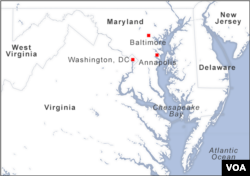The fields grow shoulder-high with weeds out the window of Bob Fitzgerald's Ford pickup. The drive through Fitzgerald's neighborhood in Princess Anne, Maryland, is a tour of dying forests and abandoned cropland.
"A few years ago, all of this was a good farm," he said. "And it's gone, as a farm."
The land along the shores of the Chesapeake Bay has been sinking for centuries. But climate change is adding a second whammy. As the sea level rises, salt water is seeping into the water table, deeper and deeper inland. The ground is becoming too salty for crops to grow.
Maryland's Eastern Shore is home to some of the oldest farms in America. Fitzgerald's dates back to 1666. He's seen big changes in his lifetime.
"You just can't believe how it's taking things over in the last 15 or 20 years," Fitzgerald said. "I can show you land around here that people raised tomatoes on when I was a little boy. And now it's gone."
Around the world, scientists warn that coastal farms are under threat from rising seas and encroaching salt water. A World Bank report estimates rice yields in coastal areas of Bangladesh may fall by more than 15 percent by 2050. Another report found that hundreds of millions of people will likely be displaced by rising waters.
Kate Tully aims to help keep Eastern Shore farmers in business as the seas rise.
The University of Maryland agroecologist had seen the "ghost forests" of dying pine trees killed by the increasingly salty soil. When she started looking at maps, she said, "I realized that a lot of the land that was upslope wasn't just forests, it was farms. And so I started poking around and talking to people and asking if this was an issue on farms."
It was. But "a lot of people hadn't really been talking about it" outside their own communities, she said.
With a new $1.1 million research grant from the U.S. Department of Agriculture, Tully and her colleagues are aiming to give farmers options.
Test plots scattered around the Eastern Shore are trying out different crops.
"One thing that I'm very pleasantly surprised about is how well the sorghum does," Tully said. The grain crop may be a good choice to feed the roughly 600 million chickens raised in the region each year. It's a hardy crop that can handle salt, drought and heavy rains.
Tully's group is also testing barley to supply the growing microbrew industry; the oilseed canola; switchgrass, a possible biofuel crop; and salt-tolerant soybeans.
Just being able to grow a crop isn't enough, though. It also has to be profitable. An economist on the team will be running the numbers.
"I never want to recommend something that would make farmers go out of business," Tully said.
But farming the land may not be the best option. Another choice is to give in to nature and turn fields into wetlands.
Wetlands attract waterfowl. Waterfowl attract hunters.
"There's money in duck hunting," Tully said. Hunting clubs will pay farmers for exclusive access to wetlands on their property. "It can be a lucrative pathway."
Tully and her colleagues are just getting started. It will be a few years before they have recommendations for what will sustain communities that have been farming this land for centuries.
"There's a lot of history there. And as these seas rise, some of that history is going underwater," Tully said. "And I find that to be a pretty moving, pretty motivating reason to try to figure out what we can do for these farmers."











